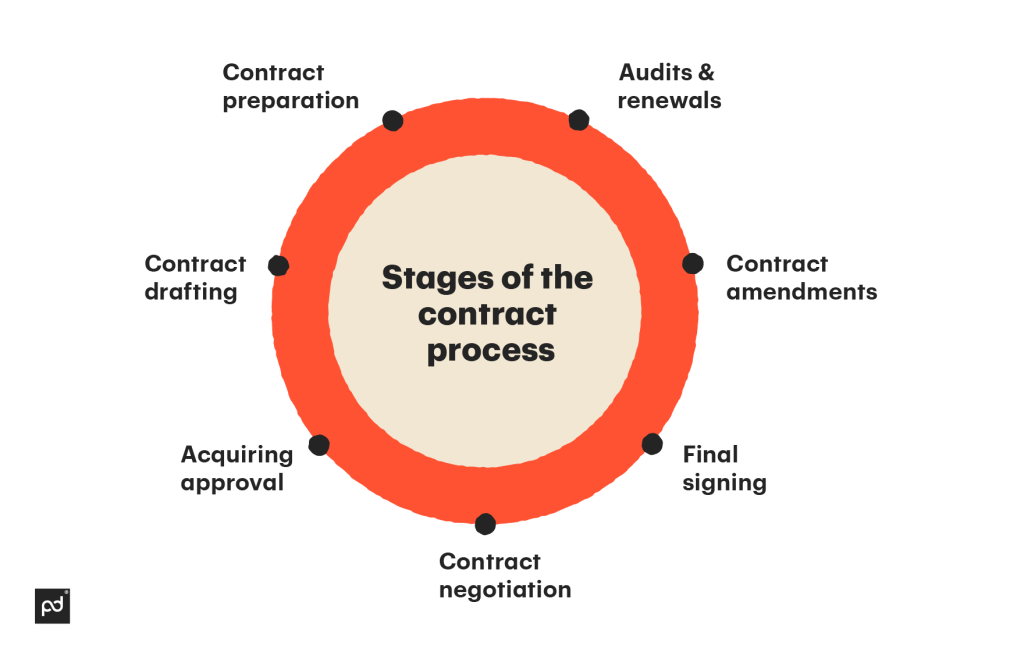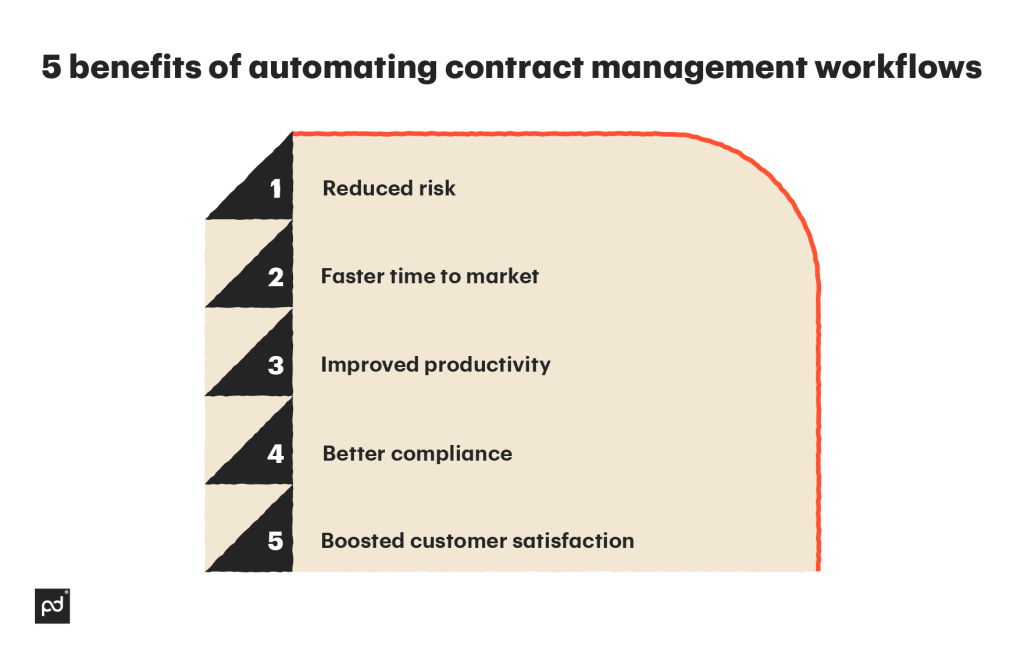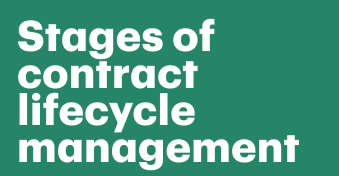Managing contracts is foundational to leading successful business processes.
With the right contract in place, you can ensure productive customer relationships while still protecting your interests in case of any disagreements.
But here’s the problem: The manual contract management process can be a real pain in the rear that wastes invaluable time.
In the long run, the manual process can easily lead to issues with contract delivery, which can negatively impact important negotiations.
The solution to complicated contract management processes is automation.
By automating your contract management workflow, you can create, sign, and track contracts faster and more efficiently.
This means you can spend less time fretting over contracts and more time serving your clients.
What is contract workflow?
Contract workflow is the process of managing a contract from the time it is created to the time it is completed.
It might seem simple at first, but there are a lot of steps along the way to take a contract from inception to completion, including:
- Information collection
- Contract creation
- External negotiation
- Approval
- E-signatures
- Contract renewals
Developing the right contract workflow for your organization is a complicated dance that involves bringing together multiple people, customers, users, and departments to facilitate the progression of the contract from creation to signature.
For example, this can include your procurement, finance, and legal team, as well as project managers and other stakeholders who are involved in executing the agreement.
And getting your contract workflow down pat is serious business.
With the average price of a basic contract ranging from $6,900 to $49,000, making a mistake can have serious implications for the overall success of your business.
What are the key stages of the contract process?
If you’ve ever had a hand in the contract process, you know it can be extensive, to say the least.
Before you understand how you can optimize the process, you should familiarize yourself with each stage so you get a better picture of where there’s room for improvement in your own contract lifecycle process.

Here’s a breakdown of the key stages in the typical contract process.
1. Contract preparation
Since contracts are legally binding documents, it’s of the utmost importance that they are prepared carefully in accordance with the specific compliance standards of your local governance standards.
Beyond being legally compliant, it’s also critical that contracts be planned out so that all of the needs of the parties involved are met.
2. Contract drafting
A contract that hasn’t been reviewed by a legal team could leave you open to risk exposure.
It’s best practice to include an in-house legal team or appropriately qualified external lawyers to review any part of a contract that you might be uncertain of while drafting the agreement.
Contract templates like those in PandaDoc’s template library can take some of the ambiguity out of the process, but it’s still highly recommended to have a qualified set of eyes review your agreement from a legal perspective before they go out the door.
3. Acquiring approval
Mid-size or large organizations typically require the sign-off of multiple stakeholders on an agreement before a contract is finalized.
Efficient companies make sure to have structured approval processes set up (more on how to do that later!) so that all of the key reviewers have the chance to put their eyes on an agreement and sign off before it moves on to the next stage.
4. Contract negotiation
Negotiations can occur early or late in the process, but it’s common for it to begin once the agreement has been somewhat finalized and is viewable by all parties involved.
With a traditional paper contract, negotiations can lead to messy on-page edits and multiple versions of the contract.
Fortunately, with digital automation, the process is much cleaner for everyone involved and it’s easier to ensure everyone has the most up-to-date version.
5. Final signing
When the time comes for final signatures, everything should be relatively straightforward.
The contract has been revised by all relevant parties, the negotiations have been completed, and both parties are happy with the terms of the agreement.
Unfortunately, the signing process can be a hassle if you’re dependent on wet ink signatures.
That’s why many modern businesses are utilizing an electronic signature solution to legally execute their contracts from anywhere, at any time.
6. Contract amendments
Even after a contract has been officially completed, it’s common for there to be subsequent revisions and amendments throughout the lifecycle of the agreement.
Perhaps the relationship between the parties involved changes and there’s a need for an amendment to the original contract.
Whatever the reason, every amendment and revision should be tracked so that everything is legally verifiable and there’s less opportunity for the other party involved to cry foul.
7. Audits and renewals
Maybe you’re thinking that by now, surely, the contract management process must be over.
Think again! It’s best practice to regularly perform audits to ensure that your contracts remain compliant and that the agreements are still in the best interest of your business.
Also, you’ll want to keep a close eye on renewal dates or make use of automated software that takes care of it for you.
Renewal expiry dates are an excellent opportunity to revise existing contracts for more favorable terms or lock in new agreements to maintain business relationships and avoid revenue loss.
Why do businesses need to update their contract workflows?
The contract management process can be tricky.
That’s why it’s so important for organizations to find a contract management workflow that works for them, helping them to manage the contract lifecycle — from initial proposal to fulfillment.
With a proper contract process in place, businesses can:
- Reduce contract management costs
- Improve contract management efficiency
- Reduce contract management risk
- Improve contract management productivity
- Reduce contract management time
Together, all of these benefits can help you improve visibility in your contracts.
This not only makes room for better decision-making but also helps you mitigate compliance risk by reducing the number of manual checks needed on contracts before they’re signed off on or executed.
How can you accelerate your contract lifecycle using automation?
To soothe your contract lifecycle management (CLM) process, you can automate your contract workflow with the help of contract management software.
Using this software will help you accelerate the entire contract workflow process — from contract requests to contract creation, contract negotiations, and finally, contract execution.
As you approach your own business processes, consider these tips to accelerate your contract workflow:
Get clear on who’s who
To set yourself on a path to success, start by making sure everyone understands who is responsible for what.
For example, you need to determine:
- Who is responsible for contract templates?
- Who will manage the approval process?
- Who will step up when it’s time to negotiate?
- Who will take care of chasing down the required signatures?
Simplify with contract templates
One way to accelerate the contract workflow process while also reducing human error is to use a contract template.
With contract templates at your disposal, you can save time by quickly finding the right documents you need.
For example, maybe you’re getting ready to work with a freelancer? Outsource certain services? Or start working with a consultant?
When you use contract templates, you can speed up your contract lifecycle management by shifting some of the burden off your legal team with done-for-you templates that you know get the job done.
Create an approval process
An approval process is a contract management workflow that requires the sign-off of one or more key individuals before being sent to a vendor or client.
Creating approval processes is perhaps the best way to improve your contract lifecycle management because it helps reduce human error by making sure nothing slips through the cracks.
Here’s an example of an effective approval process:
- A contract is created and the approval process begins.
- Legal counsel reviews the agreement and approves or rejects it.
- The finance and operations departments review the contract and approve or reject it.
- Upon receiving approval from all key departments, the contract is ready to be sent for signing.
If you’re using PandaDoc, you can create an approval process like this by opening up a template, clicking the context menu, then Setup Workflow, and then toggling the Approval option on the template.

After that, it’s as simple as adding an approver by typing their name or email address.
You can set up an approval order and even have the same person approve a contract multiple times if you want them to review the document at different stages.
By specifically marking the names of individuals who need to sign off before the contract can move forward, you’ll help to keep your team in check so they don’t miss key dates that can hold up the entire contract workflow.
The bottom line is that an effective approval process can be a critical stopgap measure that minimizes mistakes and prevents contracts with issues in them from making it out into the wild.
5 benefits of automating contract management workflows
Using automated workflows to level up your contract lifecycle management is a huge win for all parties involved.
Here are some of the top ways your company can benefit from an automated contract process.

1. Reduced risk
One of the biggest pain points when it comes to contract risk is data management, but a company that uses contract management software can make sure they correctly collect data, store data, and keep track of every important document.
Having a virtual repository to manage documents improves organization, simplifies processes to route information while mitigating human error, and, thus, minimizes contract risk.
2. Faster time to market
A faulty contract workflow can slow down everything from approvals to upcoming contract renewals, so if you want to accelerate your time to market, you know you need to pay close attention to your contract management process.
This is where it can be helpful to automate. By introducing automation to your contract management process, you can speed up approvals, connect with customers more quickly, and ultimately shorten your time to market.
3. Improved productivity
Managing the contract process manually can be a daunting task that consumes valuable time.
When you bring automation to your contracts and streamline your process for creating, approving, and renewing contracts, you take the work out of document workflow and enable your teams to stay fast-moving and productive.
4. Better compliance
Automating the contract process can be a huge help when it comes to keeping everyone on your team legally compliant.
Here are a few ways it can improve compliance:
- Lock legal content: Make sure only authorized eyes can access your contracts.
- Build a library of pre-approved clauses: Stay compliant by thinking ahead with legal teams on phrases that work.
- Create a simplified document-delivery experience: Set up versatile approval workflows that make signing contracts easy.
All of these efforts help ensure your contract process is flexible while remaining legally compliant.
5. Boosted customer satisfaction
By simplifying approval processes, speeding up communications, and making e-signatures easy, automated tools like PandaDoc take the hard work out of a workflow and make your customer’s journey a more satisfying experience.
Final thoughts
From contract creation to approval to renewal, you need to make sure that you and your team have the tools you need throughout the entire contract workflow.
That’s why PandaDoc was built for fast-moving teams like yours so you can improve your contract workflow management with automation and make it fast, simple, and sophisticated.
Disclaimer
PandaDoc is not a law firm, or a substitute for an attorney or law firm. This page is not intended to and does not provide legal advice. Should you have legal questions on the validity of e-signatures or digital signatures and the enforceability thereof, please consult with an attorney or law firm. Use of PandaDocs services are governed by our Terms of Use and Privacy Policy.


